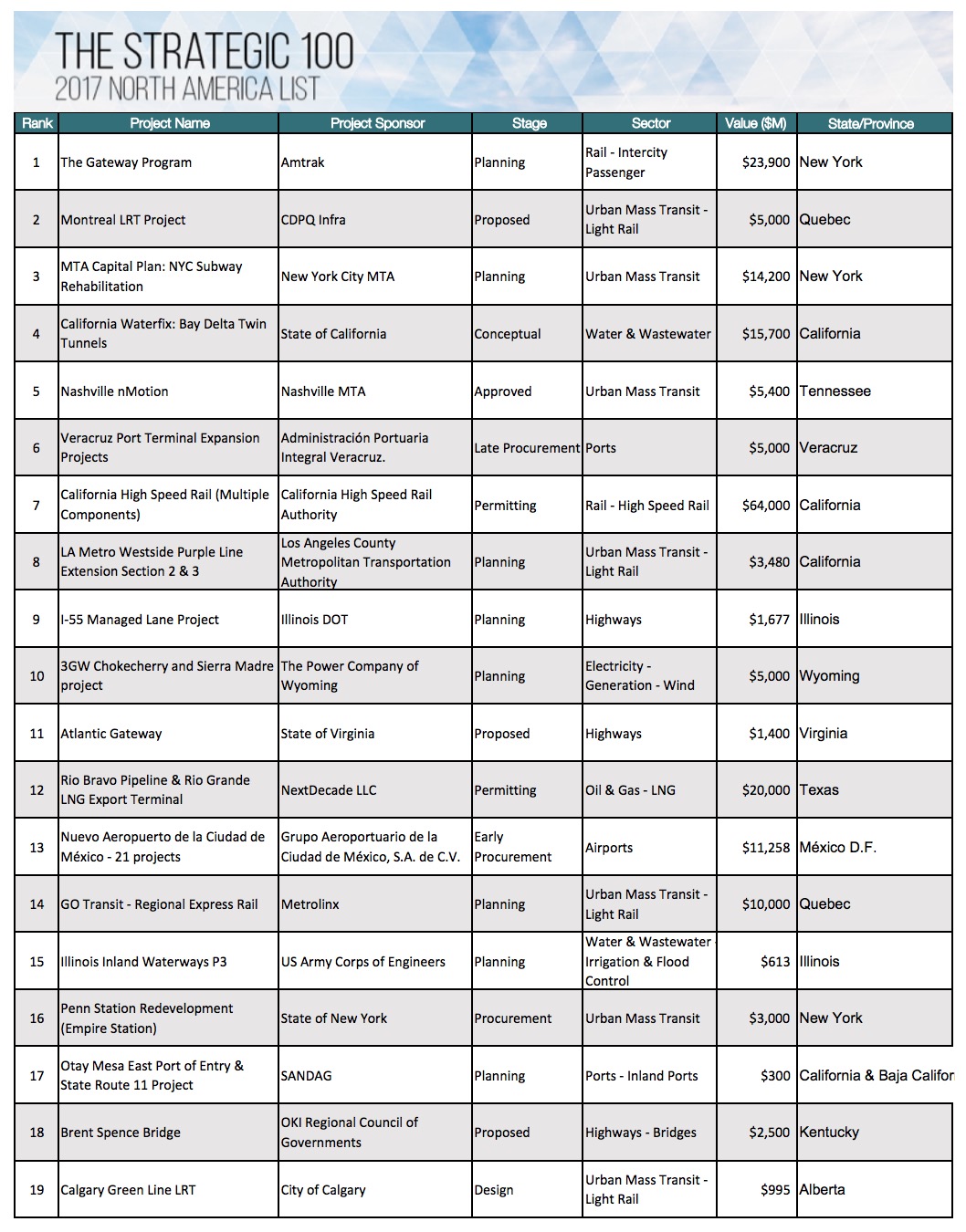CG/LA INFRASTRUCTURE
Selecting Projects for Wider Economic Benefits: An Infrastructure Strategy for Economic Impact
 An interstate highway, an urban heavy rail transit system, a water supply project, and a long-distance transmission line – all serving the same region. In a traditional infrastructure paradigm, these projects are likely developed, prioritized, and funded in individual silos, with comparison and competition for funding and permits among the projects – if it takes place at all – limited to high-level politics and informed by fragmented analysis. Is this approach satisfactory, or even sustainable? Conceptually, it is flawed, with weak mechanisms for ensuring that investments flow at the right time to the projects likely to generate the greatest long-term benefit over their lifecycle. Pragmatically, it is strained by limited public budgets that make it both harder to find funding for all worthy projects and more important to maximize broad economic returns through the mix of projects that do move forward. Making these choices is rightly difficult, yet everyone – public and private, user and builder – ultimately benefits when the economy is supported by resources flowing to the right projects, at the right time. What approaches can better help guide decision-makers through these choices?
An interstate highway, an urban heavy rail transit system, a water supply project, and a long-distance transmission line – all serving the same region. In a traditional infrastructure paradigm, these projects are likely developed, prioritized, and funded in individual silos, with comparison and competition for funding and permits among the projects – if it takes place at all – limited to high-level politics and informed by fragmented analysis. Is this approach satisfactory, or even sustainable? Conceptually, it is flawed, with weak mechanisms for ensuring that investments flow at the right time to the projects likely to generate the greatest long-term benefit over their lifecycle. Pragmatically, it is strained by limited public budgets that make it both harder to find funding for all worthy projects and more important to maximize broad economic returns through the mix of projects that do move forward. Making these choices is rightly difficult, yet everyone – public and private, user and builder – ultimately benefits when the economy is supported by resources flowing to the right projects, at the right time. What approaches can better help guide decision-makers through these choices?
Context
After years of underinvestment, infrastructure is having a moment in the policy discussion. Across North America, policy-makers are moving toward using public sector infrastructure investment as a strategy for promoting economic growth, while private infrastructure developers are seeking projects that yield healthy investment returns – returns that are harder to find over the long-term while low growth rates remain the dominant macro-narrative. This focus on infrastructure investment’s potential benefits is laudable, reflecting the advice of top economists and the emerging limits of other policy tools. Such investment, if well-targeted and well-executed, can be a path to achieve near-term economic policy objectives while dramatically improving the foundation for long-term economic prosperity. In policy discourse, however, “infrastructure investment” is too often conflated with – or just lazily simplified to – “infrastructure spending.” This convenient shorthand at best confuses the issues by placing too much emphasis on investment quantity rather than quality and at worst purposefully distorts the conversation toward a focus on short-term fiscal impacts (“expenditure”) rather than long-term economic effects (“investment”).
This discussion must be refocused on infrastructure investment if governments and industry are to transform the concept from a logical, promising policy idea into a successful program of investment – one that provides a balance of short-term and long-term benefits to users of infrastructure services, the taxpayers and private investors who underwrite those projects, and the industry that delivers them. How should this be done? One important step is to emphasize the long-term, dynamic benefits of good infrastructure projects when making budget and prioritization decisions. CG/LA calls this a wider economic benefits approach, and we have begun using it as a framework to guide our decisions in preparing the Strategic 100. The logic of this approach, illustrated using a discussion of it in relation to top projects from the Strategic 100 list, is explained below.
Wider Economic Benefits & The Strategic 100
The wider economic benefits (WEBs) framework includes those impacts – on productivity, labor markets, and business activity – that accrue dynamically to a regional or national economy and population as well as more narrowly to users and direct beneficiaries of a project. In the current economic environment, the need for a pipeline of high-quality infrastructure projects and ways to prioritize them is robust, and it is subsequently crucial that ex ante project evaluation and prioritization methods are well-aligned with the objective of maximizing long-term economic value added.
The essence of a WEBs-based approach identifying and emphasizing projects that have both a broad impact and a transformative one. They eliminate constraints on growth and open up new markets and possibilities by connecting resources and population centers in new ways. (Increasingly, priority projects may also “transform” a community or region by modernizing and extending existing assets or systems, securing their services against a future of underperformance and decline.)
How might these impacts be manifested through specific projects? The section below comments briefly on the potential impacts of several top projects from the 2017 Strategic 100:
- The Gateway Program – New York City anchors the U.S.’s largest metropolitan statistical area, and the Northeast Corridor is one of its most critical transportation axes, connecting an urban megaregion that stretches from Boston in the northeast south to Washington, D.C. Passenger rail transport depends on a pair of 100-year-old tunnels that are in danger of failure and a congested Manhattan rail station that is known neither for providing a positive user experience nor an efficient transportation one. The Gateway Program, a massive, multi-agency program to address these issues, is undeniably one of the nation’s highest priority projects – and one that offers similarly large long-term benefits. More reliable, more efficient service for rail system users is the direct outcome, but the indirect and dynamic effects of improving regional mobility and investing in iconic assets are sure to be substantial as well.
- Nashville nMotion – Serving a fast-growing metropolitan area in Tennessee that lacks the mass transit infrastructure of many longer-established leading cities, nMotion is a $6-billion, 25-year transit strategic plan that will provide a range of new transportation alternatives to the area’s citizens and businesses, facilitating continued growth and broadening access to economic opportunity
- New Mexico City Airport – One of the world’s largest and densest metropolitan concentrations, the Mexico City area is home to over 21 million people. The city’s current international airport is at full capacity, yet the region’s future growth and competitiveness as a global center depend on accessible, reliable air transport services. In 2014, the national government committed to a plan to replace the current airport with a modern, higher-capacity new one – a megaproject with both practical economic and symbolic political and cultural value.
- Atlantic Gateway – The Interstate 95 corridor through the U.S. Mid-Atlantic seaboard is notorious as one of the nation’s most congested transportation chokepoints. The corridor’s congestion and infrastructure limitations are not limited to the highway, but affect alternative modes as well, and they affect not only commuters and holiday travelers but also freight movement between key ports and major population centers. Virginia’s “Atlantic Gateway” project, announced in 2016, is a bundle of investments across modes designed to reduce friction at key bottlenecks – embodying a view that “the whole is greater than the sum of its parts” in this complex transportation system and opening new opportunities for businesses and individuals by reducing the costs of transport.
- California High-Speed Rail – The nation’s largest high-speed rail program is ambitious, controversial, and potentially transformative, illustrating the risks and rewards of infrastructure megaprojects. Delivering the planned system on a reasonable budget and timeline is an enormous challenge, but when fully implemented, this high-speed rail system holds the promise of remaking the transportation landscape in the largest state economy like no project since the beginnings of the interstate highway system. High-speed rail systems are always costly and must deliver major benefits to justify their costs; but well-designed and implemented systems can not only provide new connections between the major cities that anchor them, but also spur economic development in outlying towns and cities along the corridor, as Spain’s recent experience has demonstrated.
Projects drive prosperity and are the all-important link between infrastructure needs and infrastructure services. Selecting the right projects, building on those successes, and making conscious decisions as to the mix of projects required reflects directly on a nation’s ability to grow, to compete, and drive increased per capita income for its citizens. To accomplish this, the standard practice must move from an infrastructure project development process influenced at many stages by short-term political incentives to a more transparent one that protects the inherently political nature of public infrastructure project selection while professionalizing project appraisal (framing alternatives before selection) and delivery (constructing projects once selected). Making WEBs a focal point of infrastructure project development and valuation can raise awareness of the strategic – and at times transformative – nature of large infrastructure investments, and, by including WEBs in strategic analysis, sponsors can improve public understanding and decision-making related to projects.
About CG/LA Infrastructure
www.cg-la.com
“Infrastructure is a catalyst for progress and we believe that the right policies and projects create important opportunities for all. Our mission is to support the doubling of global infrastructure investment by 2020 and ensure that collectively, we receive the maximum benefit from that investment.”
Tags: CG/LA Infrastructure, Strategic Top 100, WEBs, Wider Economic Benefits







 RSS Feed
RSS Feed